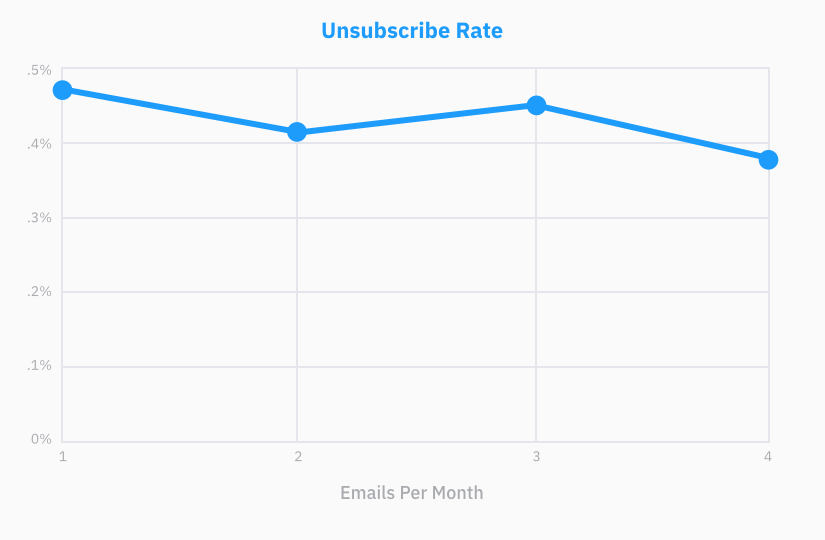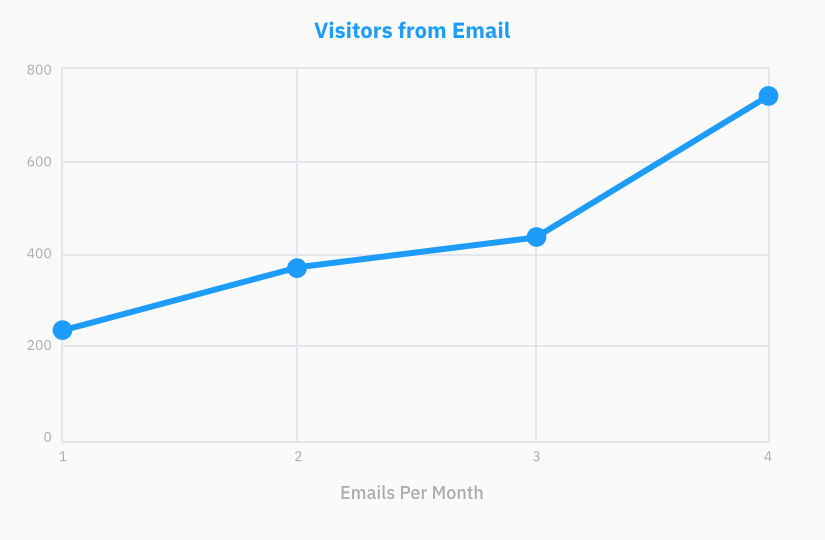These days, all marketers know that email should be a part of their marketing strategy. But a common question we get is, “how often should I be emailing my marketing list?” In this article, we’ll dive into what we’ve found from studying our clients’ email practices and explain what we’ve learned about optimizing that effort.
The frequency at which you send emails depends on a number of factors, including positioning and engagement. However, we’ve also found that these best practices change year over year. For that reason, we’ve made some adjustments to our standard benchmarking recommendations.
This article contains information that would be helpful to any marketer, but it was written more specifically for B2B, expertise-based firms.
Let’s start by tackling the most common question we get.
How Often Should I Email My List?
The short answer is once a week if you have the content to support it. That may sound like a lot to you, especially if you’re accustomed to only sending monthly newsletters.
Sending a monthly newsletter used to be considered an acceptable cadence for reaching out to your list and sharing thought leadership. Today, though, monthly emails won’t cut it — and we have the data to prove it. (Jump to the comparison now!)
So, this begs the next question.
Should I Send a Monthly Newsletter to a New Marketing List?
No, you should not send a monthly newsletter to your new marketing list. There are three reasons we don’t recommend sending monthly newsletters, especially to new or cold lists:
- Marketing emails should be sent more frequently than once a month.
- Monthly newsletters are too broad, both topically and in that they are frequently sent to your whole list. Marketing emails should be more targeted than that.
- Monthly newsletters often contain too many links, making the content load too heavy for your recipients.
Recipients are now accustomed to receiving dozens to hundreds of emails a day. Most simply scan their inboxes and delete everything that doesn’t initially appeal to them.
If you have a following, recipients might be interested in the content you produced last month, but the information in the newsletter will likely be overlooked since it is too much to consume at one time. The exception being you have a list of subscribers who signed up for and who’ve come to expect the once a month cadence. You’re almost certain to get better engagement sending a targeted email highlighting a specific article or topic.
And this should go without saying, but never send a newsletter to a cold or purchased list. If the recipient doesn’t know about your firm, sending them your “July Newsletter” won’t impress them.
Email Marketing Frequency Best Practices
We’ve already said that a weekly cadence is ideal for email marketing, Now let’s take a look at how we came to this conclusion and why.
The most important factors to consider when it comes to email frequency are consistency and reliability. You should be consistent with the regularity of your emails, and this consistency should match the expectations you set for your audience when they sign up to receive your emails. Reliability has to do with maintaining a high standard of quality in terms of the content of your emails.
As a test, we did a direct comparison of the relative success of different email frequencies as measured by the volume of email-driven site traffic. For the purposes of the test, we looked at sending emails once a month, once every other week, three times a month, and once a week for a three-month period. Weekly email sends yielded three times as many site visitors from email than monthly sends.
You might expect to see this increase given that more frequent emailing gives your list more opportunities to engage with your site. However, it’s important to note that our email engagement metrics, such as open and click rates, remained steady and did not decline as email frequency went up.
More impressively — and perhaps unexpectedly — our unsubscribe rates were lower with weekly emails, too. Email fatigue is a common objection to sending regular emails. But in this study, we actually found that we experienced a decrease in unsubscribe rates when we sent emails on a consistent basis. When we sent emails less predictably (once a month and three times a month), our unsubscribe rate increased.

Send Emails Consistently at the Same Time
Ideally, you should establish a consistent sending schedule that allows your audience to become accustomed to the frequency of your email marketing promotions. This helps minimize surprises for your audience. If you send infrequently and inconsistently, users will no longer rely on your expertise. This can lead to a drop-off in engagement, and ultimately, an increase in unsubscribes.
Sending at the same time each week goes further in establishing reliability in your communication. If you consistently send your emails early in the morning, your audience can depend on your email to be there each week on their commute to work. If you send consistently in the afternoon, your audience can enjoy your content as they enjoy their lunch break. You get the idea.
What Do I Email to my Marketing List?
You should send your marketing list your thoughtful and relevant content. The tighter your company’s positioning and expertise, the easier this is to do.
However, to be clear, thoughtful and relevant content does not include the following:
- Your sales pitch.
- Your case studies.
- The awards you’ve won.
- The details of your company outing or event.
We do not suggest or condone sending weekly sales emails. Your emails should deliver valuable insights to your subscribers. Your priority should absolutely not be to send an email for the sake of adhering to your sending schedule while hoping for opens and clicks.
Some clients will feel like they’re sending out too much content and worry that their lists won’t find it valuable. In It’s Time to Stop Considering Your Marketing Spam, Lauren McGaha explained that some agencies don’t “value their own marketing enough to stomach the promotion it deserves. The real issue [is] they [are] afraid that if they promoted their own content, they’d look like spammers.”
Many users are accustomed to receiving weekly emails from senders. Others sign up to receive daily emails. You have the opportunity to train your audience to become accustomed to your preferred email style.
With that being said, our recommended email cadence is one email per week – assuming you have the content to support it, of course. A weekly emailing cadence allows you to develop a regular touchpoint with your audience while keeping your brand top of mind and demonstrating your expertise in your field. If you don’t have a backlog of thought-leadership content, then content creation needs to be your first objective. And if your team struggles to produce high-quality content at a rate that allows for weekly email promotions, you might want to consider getting in touch with us about our Content Development Services.
